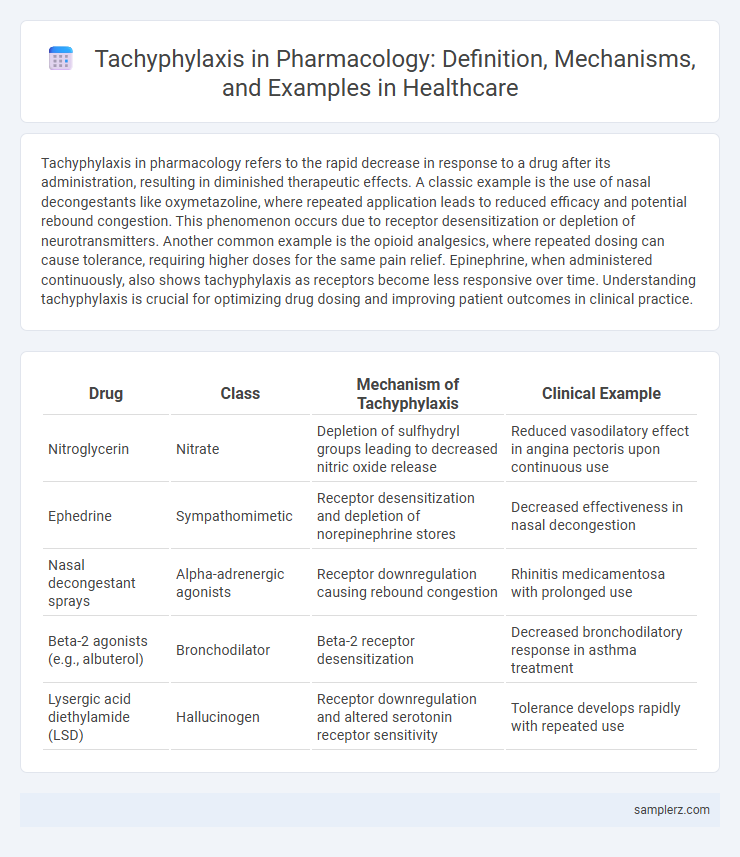Tachyphylaxis in pharmacology refers to the rapid decrease in response to a drug after its administration, resulting in diminished therapeutic effects. A classic example is the use of nasal decongestants like oxymetazoline, where repeated application leads to reduced efficacy and potential rebound congestion. This phenomenon occurs due to receptor desensitization or depletion of neurotransmitters. Another common example is the opioid analgesics, where repeated dosing can cause tolerance, requiring higher doses for the same pain relief. Epinephrine, when administered continuously, also shows tachyphylaxis as receptors become less responsive over time. Understanding tachyphylaxis is crucial for optimizing drug dosing and improving patient outcomes in clinical practice.
Table of Comparison
| Drug | Class | Mechanism of Tachyphylaxis | Clinical Example |
|---|---|---|---|
| Nitroglycerin | Nitrate | Depletion of sulfhydryl groups leading to decreased nitric oxide release | Reduced vasodilatory effect in angina pectoris upon continuous use |
| Ephedrine | Sympathomimetic | Receptor desensitization and depletion of norepinephrine stores | Decreased effectiveness in nasal decongestion |
| Nasal decongestant sprays | Alpha-adrenergic agonists | Receptor downregulation causing rebound congestion | Rhinitis medicamentosa with prolonged use |
| Beta-2 agonists (e.g., albuterol) | Bronchodilator | Beta-2 receptor desensitization | Decreased bronchodilatory response in asthma treatment |
| Lysergic acid diethylamide (LSD) | Hallucinogen | Receptor downregulation and altered serotonin receptor sensitivity | Tolerance develops rapidly with repeated use |
Understanding Tachyphylaxis: Definition and Significance
Tachyphylaxis is a rapid decrease in the response to a drug after repeated administration, commonly observed with medications like nitroglycerin and nasal decongestants. This phenomenon results from receptor desensitization or depletion of mediators, leading to diminished therapeutic effects. Understanding tachyphylaxis is crucial for optimizing drug dosing regimens and preventing treatment failure in clinical practice.
Common Drugs Associated with Tachyphylaxis
Common drugs associated with tachyphylaxis include nitroglycerin, which rapidly loses effectiveness in treating angina due to receptor desensitization. Nasal decongestants like oxymetazoline show diminished vasoconstrictive response after prolonged use, leading to rebound congestion. Beta-agonists such as albuterol often exhibit reduced bronchodilator effect in asthma patients after repeated administration.
Nitroglycerin: Rapid Tolerance in Angina Treatment
Nitroglycerin exhibits tachyphylaxis, a rapid decrease in drug response during angina treatment, limiting its long-term efficacy. This phenomenon occurs due to depletion of sulfhydryl groups and increased oxidative stress in vascular smooth muscle cells, reducing nitric oxide bioavailability. Clinically, intermittent dosing schedules are used to prevent tolerance and maintain therapeutic benefits.
Decongestants: Tachyphylaxis in Nasal Spray Medications
Tachyphylaxis in pharmacology is exemplified by nasal decongestants such as oxymetazoline and phenylephrine, where repeated use leads to diminished efficacy and rebound congestion. This rapid tolerance occurs due to receptor desensitization and downregulation in the nasal mucosa's adrenergic receptors. Limiting decongestant use to 3 consecutive days helps prevent tachyphylaxis and reduces the risk of rhinitis medicamentosa.
Beta-Agonists and Tachyphylaxis in Asthma Management
Beta-agonists, such as albuterol, are commonly used bronchodilators in asthma management that can exhibit tachyphylaxis, where repeated use leads to diminished drug responsiveness. This reduced efficacy occurs due to beta-2 adrenergic receptor desensitization and downregulation on airway smooth muscle cells. Monitoring and limiting short-acting beta-agonist use can help mitigate tachyphylaxis and maintain optimal asthma control.
Antidepressants: Diminished Response Over Time
Tachyphylaxis in pharmacology is exemplified by antidepressants, where patients experience a diminished therapeutic response after prolonged use despite an initially effective treatment. This phenomenon is often observed with selective serotonin reuptake inhibitors (SSRIs) and tricyclic antidepressants, leading to reduced efficacy in managing depression symptoms over time. Mechanisms include receptor desensitization and neuroadaptive changes in serotonin pathways, necessitating dosage adjustments or medication switches.
Opioids and the Development of Tachyphylaxis
Opioids frequently induce tachyphylaxis, characterized by a rapid decrease in drug efficacy after repeated administration, complicating pain management in clinical settings. This phenomenon results from receptor desensitization and downregulation of mu-opioid receptors in the central nervous system. Understanding the mechanisms behind opioid-induced tachyphylaxis is critical for optimizing dosing regimens and mitigating tolerance development.
Histamine Receptor Antagonists: Gastric Acid Suppression
Tachyphylaxis in pharmacology often occurs with Histamine H2 receptor antagonists such as ranitidine and famotidine, used for gastric acid suppression. These agents initially block histamine-induced gastric acid secretion effectively, but rapid tolerance develops within days due to receptor desensitization and compensatory mechanisms. This reduced therapeutic response necessitates alternative treatments, like proton pump inhibitors, for sustained acid control in conditions like peptic ulcers and gastroesophageal reflux disease.
Strategies to Prevent or Manage Tachyphylaxis
Tachyphylaxis frequently occurs with drugs like nitroglycerin and beta-2 agonists, where repeated exposure leads to diminished therapeutic effects. Strategies to prevent or manage tachyphylaxis include drug rotation, intermittent dosing, and the use of drug holidays to restore receptor sensitivity. Monitoring patient response and adjusting medication regimens accordingly can optimize long-term treatment efficacy.
Clinical Implications: Tachyphylaxis and Patient Outcomes
Tachyphylaxis, the rapid decrease in drug response after initial administration, commonly occurs with medications like nitroglycerin and nasal decongestants, leading to diminished therapeutic effects. Clinically, this phenomenon necessitates careful dose adjustment or drug holidays to maintain efficacy and prevent treatment failure. Understanding tachyphylaxis is critical for optimizing patient outcomes and avoiding adverse effects linked to drug tolerance.

example of tachyphylaxis in pharmacology Infographic
 samplerz.com
samplerz.com